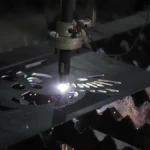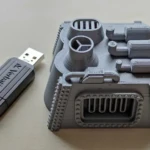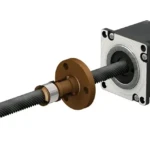In recent years, anodizing of aluminum alloys has become very popular, from military aerospace to civilian use. Because aluminum alloys are light, have large storage capacity, are easy to process, and have good surface treatment effects, they are increasingly used in civil products. In particular aeronautical aluminum alloys 6061, 7075, 7050, 7050, 7061, 7050, 7050, 7061, 7061, 7050, 7050, 6061, 7050, 6061, 7061, 7075, 7050, So the market acceptance is getting better and better.
When it comes to choosing the right type of aluminum for your project, you may be unsure which one to choose. 6061 and 7075 are the two most common aluminum materials, but what is the difference between them?
In this blog post, we will discuss the differences between 6061 and 7075 aluminum so that you can make the best decision based on your needs.
1
What is aluminum alloy?
Aluminum alloy is a silver-white, soft, non-magnetic and ductile boron group metal. Aluminum represents approximately the proportion of the mass of the earth’s crust; it is the third most abundant element after oxygen and silicon and the most abundant metal in the earth’s crust. Deep in the mantle and crust, the abundance of aluminum decreases relative to other elements.
Characteristics of pure aluminum: More than 99.00% aluminum, good conductivity, corrosion resistance, good welding performance, low resistance, no need for reinforcement by heat treatment.
Scope of application: mainly used in lighting fixtures, reflectors, decorations, chemical industry containers, heat sinks, welding wires, conductive materials and special purposes.
Typical qualities of pure aluminum: aluminum 1050, aluminum 1060
2
About the meaning of 6061 aluminum and 7075 aluminum
What is 6061 aluminum?
Aluminum alloy 6061 is an aluminum alloy with silicon and magnesium as the main alloying elements. The magnesium content is 0.8-1.2% and the silicon content is 0.4-0.8%. It is a versatile aluminum material that can be used in various applications.
6061 aluminum has the characteristics of easy processing and welding, easy electroplating, good toughness, easy deformation, easy polishing and surface treatment, ‘strong corrosion resistance and can be heat treated to increase its strength.
What is 7075 aluminum?
7075 aluminum is an alloy with zinc as the main alloying element. Unlike other aluminum alloys, it is one of the strongest alloys available, making it popular for applications requiring high strength. 7075 aluminum has good weldability and machinability, but cannot be heat treated like 6061 aluminum.
Series 7 aluminum alloys contain zinc and magnesium. Zinc is the main alloying element in this series, so it resists corrosion very well, while a little magnesium alloy allows the material to achieve very high strength when heated. The 7075 aluminum alloy has an excellent weight-to-strength ratio and is well suited to highly stressed parts. Depending on requirements, operations such as molding and heat treatment can be carried out.
3
About the difference between 6061 aluminum and 7075 aluminum alloy
3.1 Chemical composition
The main alloying elements of 6061 aluminum are magnesium and silicon, while the main alloying element of 7075 aluminum is zinc. Here is their list of ingredients:
3.2 Mechanical properties
Mechanical properties include tensile strength, shear strength, yield strength, thermal conductivity, high temperature resistance, resistivity, material hardness, corrosion resistance, etc. We will share the above problems with you.
6061-T651 is heat treated to achieve high strength. 7075-T651 has excellent mechanical properties and is used in the manufacture of aircraft structures and other parts subject to high stress.
Tensile Strength: 7075 has almost twice the tensile strength of 6061, making it the stronger of the two alloys.
The 7075 is also more expensive than the 6061 and therefore less used.
Shear Strength: The shear strength of 7075 is 1.5 times that of 6061 aluminum alloy, making it ideal for structural applications.
However, 7075 is more prone to stress cracking than 606.
Therefore, the potential for stress cracking must be carefully considered when selecting this material for a specific application.
The yield strength of an aluminum alloy is a measure of its ability to resist deformation under load. The higher the yield strength, the more resistant the material is to deformation.
The yield strength of 7075 aluminum is 503Mpa, while the yield strength of 6061 aluminum is 276Mpa. This means that 7075 aluminum has higher warp resistance than 6061 aluminum.
Thermal conductivity: Anyone who has worked with aluminum knows that the metal is an excellent conductor of heat, however, not all aluminum alloys are equal in this regard. For example, 6061 aluminum has a thermal conductivity of approximately 220 watts per Kelvin meter, while 7075 aluminum has a thermal conductivity of approximately 169 watts per Kelvin meter.
This difference may seem small, but in applications where cooling is critical, it can be significant.
Resistivity: When selecting aluminum alloys for electrical applications, it is essential to consider the resistivity of the metal. Among the most popular aluminum alloys, 6061 aluminum has the lowest resistivity, making it an excellent choice for electrical conductor applications. 7075 aluminum, on the other hand, has a higher resistivity and is less suitable for electrical conductor applications.
High Temperature Resistance: A key difference is that alloy 6061 can withstand higher temperatures than alloy 7075. It is often preferred in applications where parts are exposed to high temperatures. 7075 aluminum also exhibits excellent response to heat treatment, making it ideal for applications requiring high strength.
Although both alloys offer unique properties, 7075 aluminum is generally considered harder than 6061 aluminum.
The increased hardness makes 7075 aluminum more resistant to wear, making it ideal for applications where durability is essential.
3.3 Areas of application
6061 aluminum is used in the manufacturing of aircraft parts, camera parts, marine parts, valve parts, trucks, trailers, boats, furniture and construction applications.
Aluminum alloy 7075 is primarily used to make aircraft structures and other high-stress parts. For example, carrying parts of airplanes, landing gears, rockets, propellers and spacecraft.
As you can see, there are many differences between 6061 aluminum and 7075 aluminum. When choosing the right type of aluminum for your project, it is important to keep these differences in mind so that you can make the best decision according to your needs.
3.4 Processing technology
6061 aluminum is a versatile heat treatable aluminum alloy that can be manufactured by milling, drilling, tapping, punching and machining. It has good weldability and can be easily connected by any methods. 7075 aluminum is a zinc aluminum alloy that has good weldability and machinability, but cannot be heat treated like 6061 aluminum. 6061 and 7075 aluminum can be anodized to improve corrosion resistance and to wear.
3.5 Cost of material
In market sales, the utilization rate of 6061 is higher than that of 7075. Generally, 6061 is the best-selling aluminum alloy material because its performance is basically in line with various industrial uses such as processing mechanics and equipment processing. a domestic aluminum alloy brand and has gained popularity in traditional use and won unanimous praise from the majority of manufacturers.
Choosing 6061 as a raw material has therefore become a habit. The production and processing cost of 6061 is also relatively low, so the supply and utilization of 6061 is relatively huge.
4
Frequently asked technical questions about aluminum alloys
Q: What is the heat treatment process of aluminum?
Answer: Aluminum heat treatment is a process that changes the physical and mechanical properties of aluminum. Heat treatment can be used to increase the strength, hardness and/or ductility of aluminum. It can also be used to improve the corrosion resistance, electrical conductivity or processability of aluminum.
Q: What are the standards for aluminum alloys?
Answer: Standards for aluminum alloys are formulated by the International Organization for Standardization (ISO), the American Society for Testing and Materials (ASTM), and the International Alloy Nomenclature System (IADS).
Q: What are the most common types of aluminum alloys?
A: The most common types of aluminum alloys are 6061, 7075 and 5052. 6061 aluminum is the most widely used alloy and has a good balance of strength, corrosion resistance and workability. 7075 aluminum is strong and resistant to stress cracking, making it ideal for aerospace applications. 5052 aluminum is flexible and easy to weld, making it a popular choice for applications such as fuel tanks and boat hulls.
Q: What are the surface finishes of aluminum alloys?
Answer: The surface treatment of aluminum alloy can be anodized, polished, brushed or milled. Anodizing is a process that improves the corrosion resistance of aluminum by increasing the thickness of the oxide layer. Polishing and brushing can improve the appearance of aluminum. Mill finishing is a process that gives aluminum surfaces a dull, matte finish.
Q: What are the common applications of 6061 aluminum?
A: Some common applications for 6061 aluminum include aircraft structures, the automotive industry, truck and trailer chassis, machine parts, and sporting goods. Aluminum 6061 is commonly used in the food industry for its corrosion resistance and hygienic properties. It is also used in various applications in the construction industry such as doors, windows, roofing and exterior cladding. 6061 aluminum is also a popular choice for manufacturing recreational equipment such as boats, bicycles and camping equipment.
Daguang focuses on providing solutions such as precision CNC machining services (3-axis, 4-axis, 5-axis machining), CNC milling, 3D printing and rapid prototyping services.
























